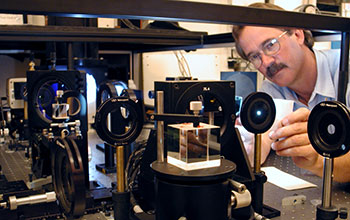Multimedia Gallery
Solar Adaptive Optics
Steve Hegwer, technical support manager of the Dunn Solar Telescope at the National Science Foundation's (NSF) National Solar Observatory (NSO) in Sunspot, N.M., inserts a white card into the light path of the Dunn's high-order adaptive optics system to check part of its operation. The system compensates for most of atmospheric blurring and allows the telescope to observe up to seven times sharper than before (0".14, corrected, compared to 1".0, uncorrected). Success with this project has paved the way for NSO to design and propose the NSF-funded four-meter Advanced Technology Solar Telescope, the world's largest optical solar telescope. (Date of Image: unknown)
Credit: Dave Dooling, NSO/AURA/NSF
See other images like this on your iPhone or iPad download NSF Science Zone on the Apple App Store.
Special Restrictions: The materials created, authored and/or prepared by the National Solar Observatory (NSO) are copyrighted in content, presentation and intellectual or creative origin. Before using this image, you must first read the Conditions of Use for NSO Images. Use of NSO/AURA images constitutes acceptance of these guidelines.
Images and other media in the National Science Foundation Multimedia Gallery are available for use in print and electronic material by NSF employees, members of the media, university staff, teachers and the general public. All media in the gallery are intended for personal, educational and nonprofit/non-commercial use only.
Images credited to the National Science Foundation, a federal agency, are in the public domain. The images were created by employees of the United States Government as part of their official duties or prepared by contractors as "works for hire" for NSF. You may freely use NSF-credited images and, at your discretion, credit NSF with a "Courtesy: National Science Foundation" notation.
Additional information about general usage can be found in Conditions.
Also Available:
Download the high-resolution JPG version of the image. (2.1 MB)
Use your mouse to right-click (Mac users may need to Ctrl-click) the link above and choose the option that will save the file or target to your computer.

